class: center, middle, inverse, title-slide # Human Development Disparities and Convergence across Districts of Indonesia: ## A Spatial Econometric Approach ### Carlos Mendez<br /><a href="https://carlos-mendez.rbind.io" class="uri">https://carlos-mendez.rbind.io</a><br /><br />Associate Professor<br />Graduate School of International Development<br />Nagoya University<br /> JAPAN ### Prepared for the Applied Regional Science Conference (ARSC) 34th/2020 Annual Meeting<br /><br />[ Slides and paper available at: <a href="https://quarcs-lab.org/research" class="uri">https://quarcs-lab.org/research</a> ] --- class: center, middle <style type="text/css"> .highlight-last-item > ul > li, .highlight-last-item > ol > li { opacity: 0.5; } .highlight-last-item > ul > li:last-of-type, .highlight-last-item > ol > li:last-of-type { opacity: 1; } </style> ### Joint work with Ragdad Cani Miranti Nagoya University and BPS Central Statistics Agency of Indonesia --- class: middle, center # A summary of the paper in 2 slides... --- class: highlight-last-item ## Motivation: - Regional inequality is important for sustainable development -- - High economic and social inequality across the provinces of Indonesia. - Limited research about regional inequality across districts of Indonesia -- - Spatial dependence and the performance of geographical neighbors affect the patters of regional inequality -- ## Research Objective: Study the effect of spatial dependence on the evolution of regional inequality. - Focus on the speed of regional convergence -- ## Methods: - Exploratory spatial data analysis: Global and local spatial autocorrelation -- - Spatial convergence models (SLM and SEM) for cross-sectional data -- ## Data: - Novel dataset about the human development index and its components -- - 514 districts over the 2010-2018 period -- --- class: middle, highlight-last-item ## Main Results: 1. **Regional disparities have been decreasing** in the overall index of human development as well as in most of its components. - Only the expenditure component shows increasing disparities -- 2. Considerable **differences in the speed of regional convergence across components** of human development - Education-related components have tended to accelerate the speed of regional convergence - Life expectancy and expenditure components have tended to decelerate it. -- 3. An **increasing degree of spatial dependence** associated with decreasing regional disparities. -- 4. The performance of neighboring regions has a **significant effect on the speed of regional convergence**. - Particularly for the expenditure component --- class: middle # Outline of this presentation 1. Brief overview of data and methods 2. Increasing spatial dependence is mostly associated with decreasing regional disparities 3. Differences in the speed of regional convergence across components of human development 4. Neighbors' effect on the speed of regional convergence <br /> <br /> [ Slides and paper available at: https://quarcs-lab.org/research ] --- class: center, middle # (1) Brief overview of data and methods --- class: middle # Data and definitions - Sample: 514 districts over the 2010-2018 period - Variables: Subnational human development index of Indonesia (HDI) - Life expectancy at birth (LE) - Expected years of schooling (EYS) - Mean years of schooling (MYS) - Expenditure per-capita (EXP) - Spatial connectivity structure (W matrix) - Non-zero values of `\(w_{ij}\)` represent a ”neighbor” relationship in a geographical sense. - Constructed based on an distance decay criteria: inverse distance --- class: middle, center # Beta convergence framework ## Useful to characterize a catch-up process 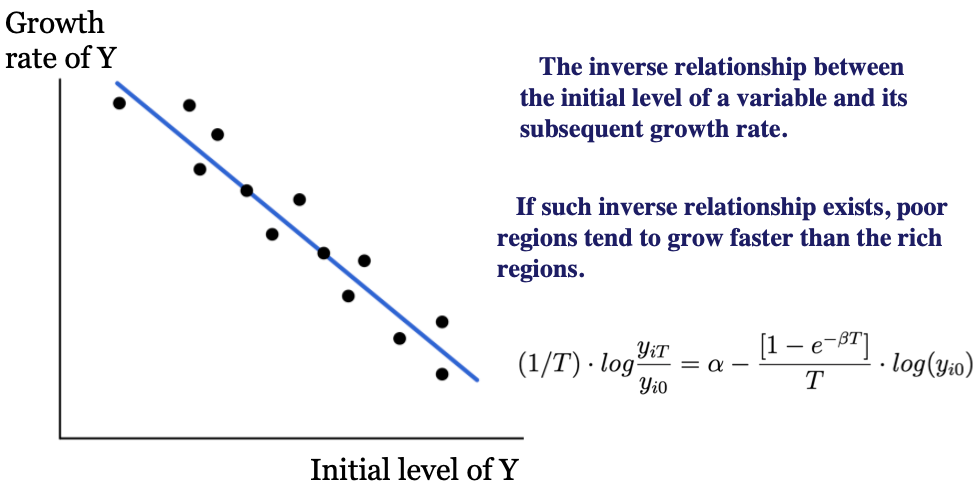 --- class: middle, center # Two simple spatial convergence models ## Regions interact and their performance is interdependent across space  --- class: middle, center # (2) Increasing spatial dependence and decreasing regional disparities (Except for expenditure per capita) --- class: middle, center ## Human development index (HDI) 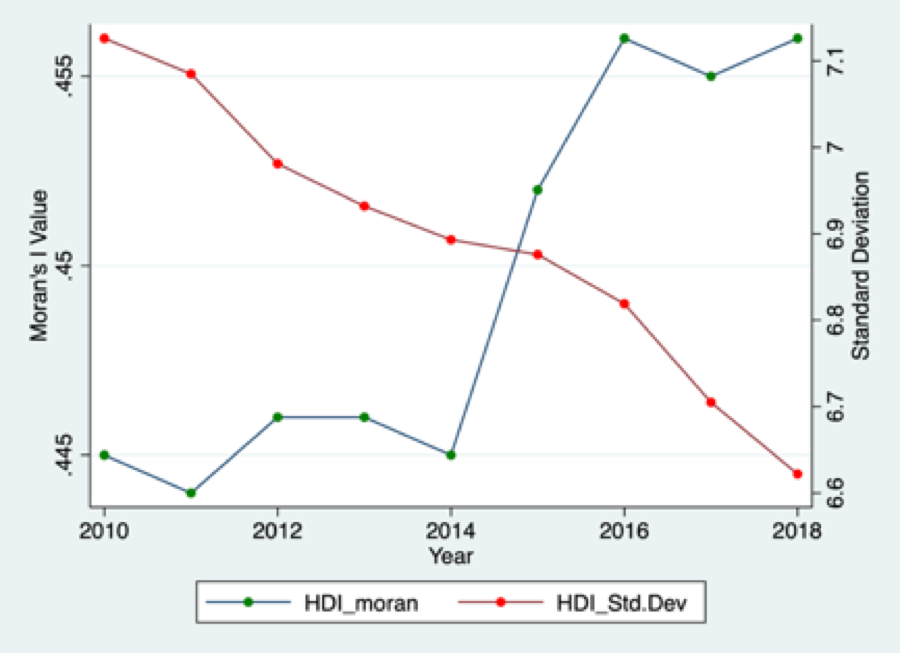 --- class: middle, center ## Life expectancy (LE) 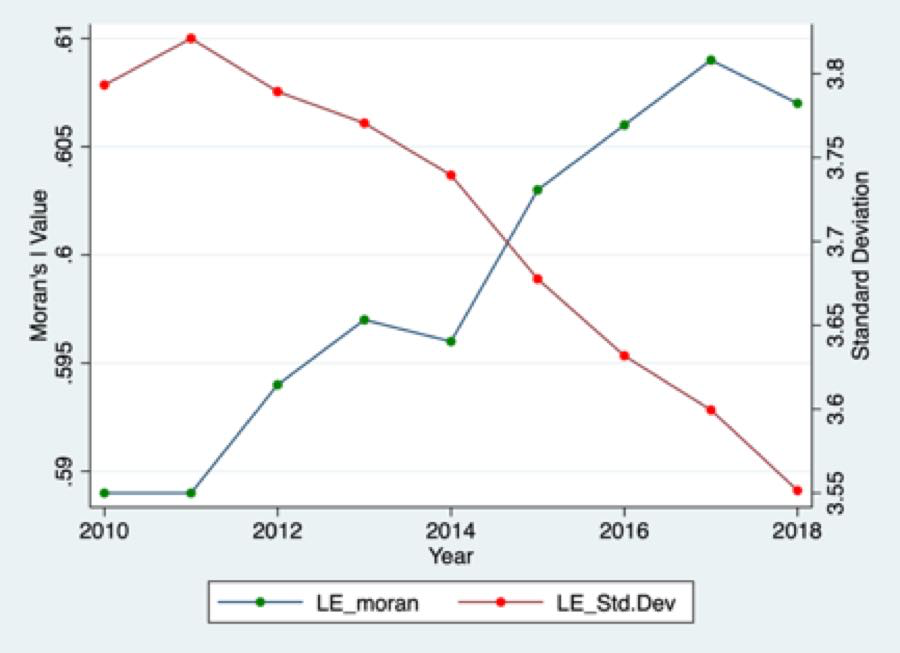 --- class: middle, center ## Expected years of schooling (EYS) 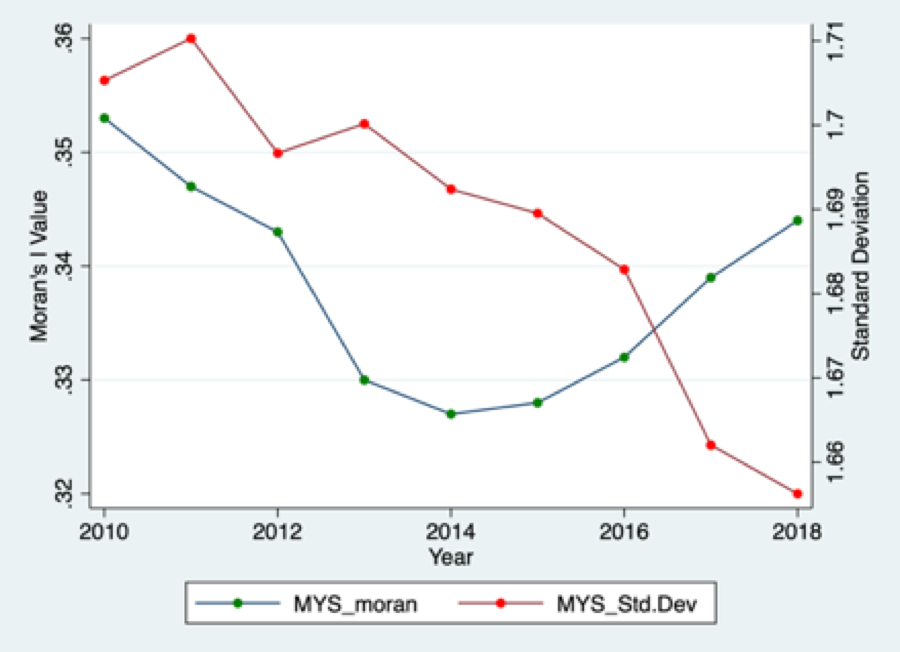 --- class: middle, center ## Mean years of schooling (MYS) 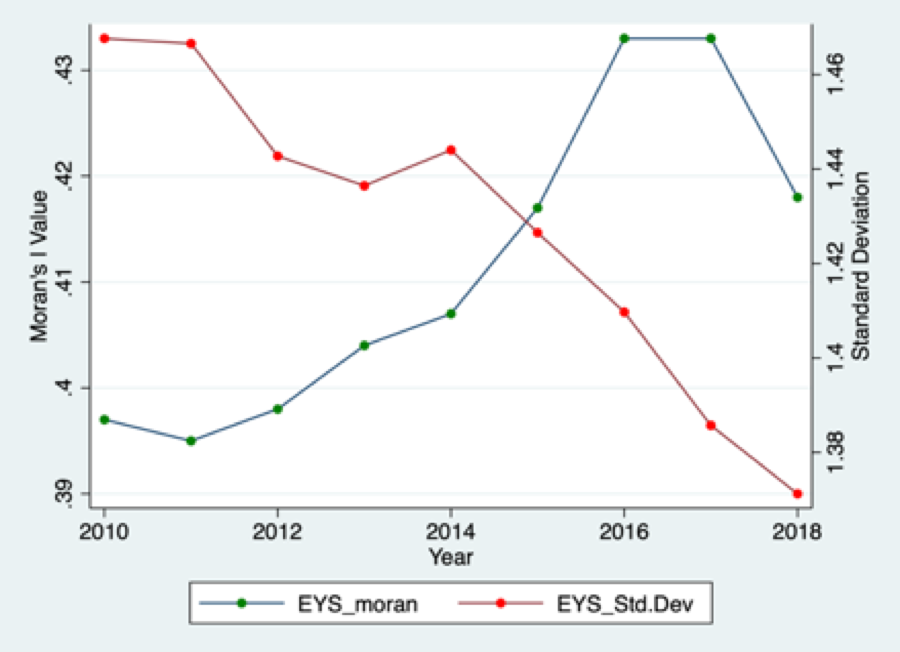 --- class: middle, center ## Expenditure per capita (EXP) 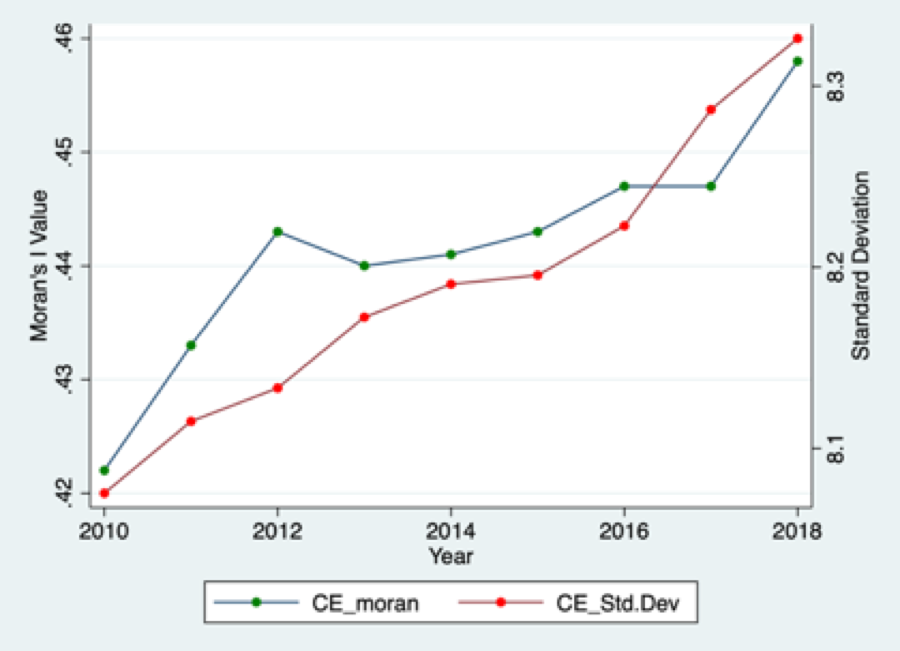 --- class: middle, center # (3) Convergence differences across components of human development --- class: middle, center 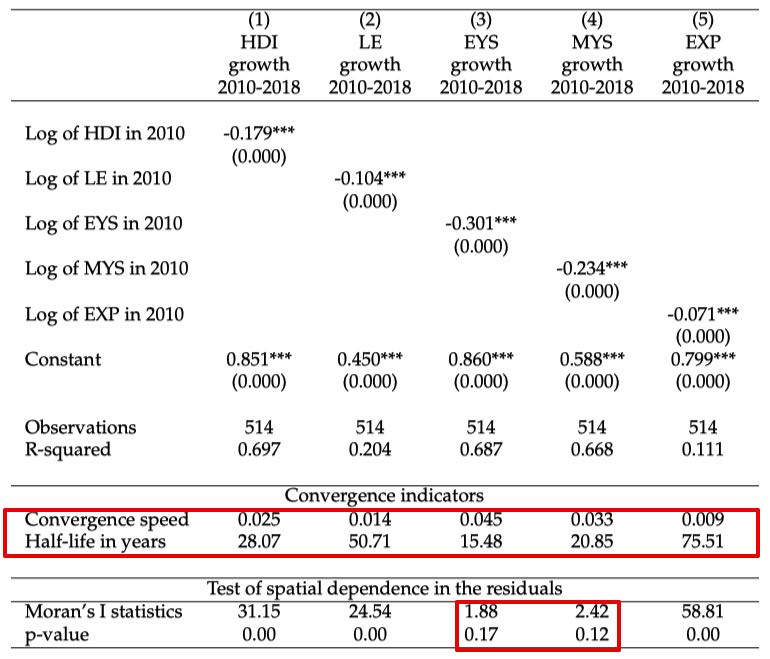 --- class: middle, center # (4) Neighbors' effect on the speed of regional convergence --- class: middle, center ## Spatial convergence models for the human development index 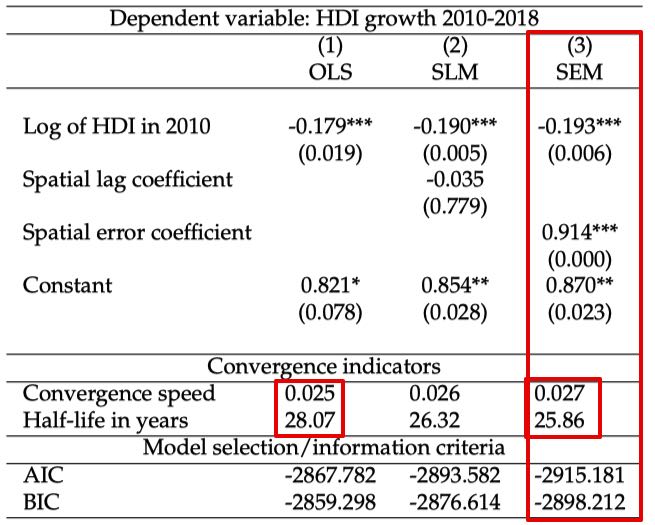 --- class: middle, center ## Spatial convergence models for life expectancy 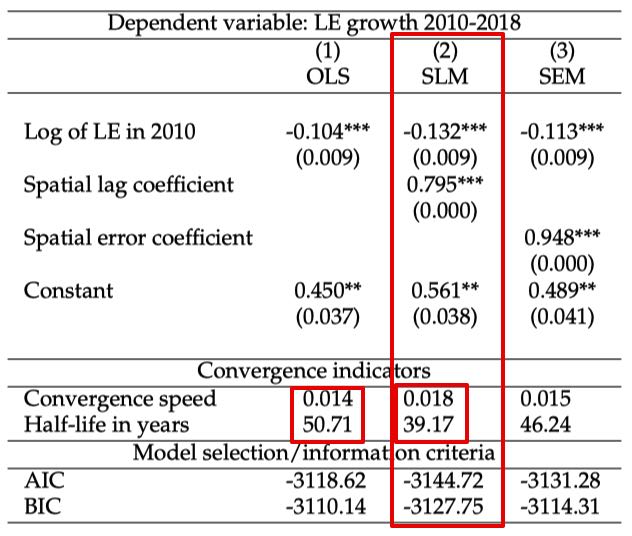 --- class: middle, center ## Spatial convergence models for expenditure per capita  --- class: middle, center ## Spatial spillover effects (LeSage and Pace, 2009) 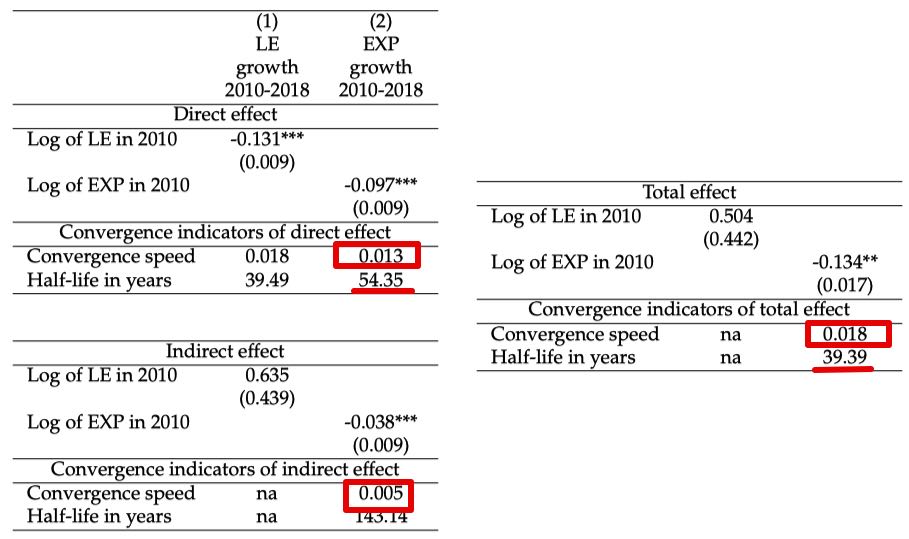 --- class: highlight-last-item # Concluding Remarks 1. **Regional disparities have been decreasing** in the overall index of human development as well as in most of its components. - Disparities in the expenditure component are increasing -- 2. **Increasing spatial dependence** for the overall index of human development and all its components -- 3. Considerable **differences in the speed of regional convergence across components** of human development - Education-related components accelerate the speed of regional convergence - Life expectancy and expenditure components decelerate the speed of regional convergence -- 4. The performance of neighboring regions has a **significant effect on the speed of regional convergence**. - Particularly in the case of expenditure per capita --- class: highlight-last-item ## Implications -- - Across districts of Indonesia, **economic disparities are more prevalent** than the social disparities indicated by the human development index -- - **Spatial dependence is important** for understanding the dynamics of economic and social inequality across districts -- - **Economic spatial externalities are could be larger** than social spatial externalities -- ## Further research -- - Use other spatial dependence specifications in a panel-data setting. -- - Use a conditional beta convergence approach -- - Study the role of spatial heterogeneity based on a GWR approach -- --- class: center, middle # Thank you very much for your attention https://carlos-mendez.rbind.io Slides and working paper available at: https://quarcs-lab.org/research  **Quantitative Regional and Computational Science lab** https://quarcs-lab.org *** This research project was supported by JSPS KAKENHI Grant Number 19K13669 --- # References (I) - Akita, T. (2002). Regional income inequality in Indonesia and the initial impact of the economic crisis. Bulletin of Indonesian Economic Studies, 38(2), 201-222. - Barro, R., & Sala‐i‐Martin, X. (1992). Convergence. Journal of Political Economy, 100(2), 223– 251. - Esmara, H. (1975). Regional income disparities. Bulletin of Indonesian Economic Studies., 11(1), 41– 57. - Gunawan, A., Mendez, C. & Santos‐Marquez, F. (2019). Regional income disparities, distributional convergence, and spatial effects: Evidence from Indonesia (MPRA Working Paper No. 95972). - Kurniawan, H., de Groot, H. L., & Mulder, P. (2019). Are poor provinces catching‐up the rich provinces in Indonesia? Regional Science Policy & Practice, 11(1), 89– 108. - Mendez, C. (2020). Convergence Clubs in Labor Productivity and its Proximate Sources: Evidence from Developed and Developing Countries. Springer. https://doi.org/10.1007/978-981-15-8629-3 - Mendez, C. (2020). Regional efficiency convergence and efficiency clusters: Evidence from the provinces of Indonesia 1990-2010. Asia-Pacific Journal of Regional Science, 4(2), 391–411. https://doi.org/10.1007/s41685-020-00144-w - Mendez, C., & Kataoka, M. (2020). Disparities in Regional Productivity, Capital Accumulation, and Efficiency across Indonesia: A Club Convergence Approach. Review of Development Economics, Online First. https://doi.org/10.1111/rode.12726 --- # References (II) - Mishra, S. C. (2009). Economic inequality in Indonesia: Trends, causes and policy response. Colombo, Sri Lanka: UNDP Regional Office. - Phillips, P., & Sul, D. (2007). Transition modeling and econometric convergence tests. Econometrica, 75(6), 1771– 1855. - Phillips, P., & Sul, D. (2009). Economic transition and growth. Journal of Applied Econometrics, 24(7), 1153– 1185.